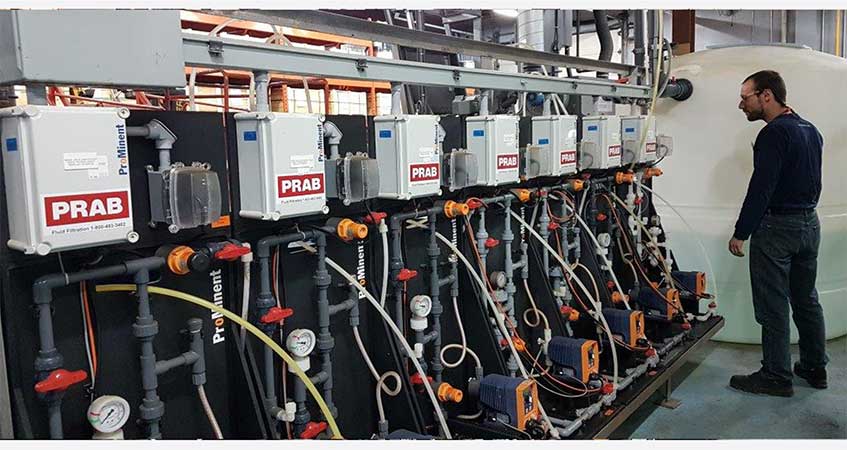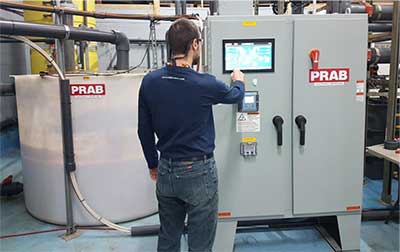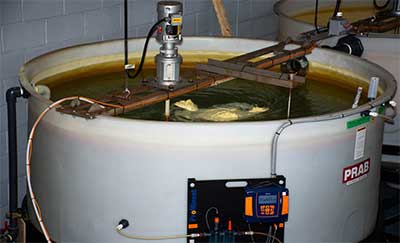Tube-Mac Piping Technologies had been sending their piping components to an outside company to complete a zinc plating process just before the components were shipped or put into inventory. The logistics of sending the piping components out for plating was cumbersome, costly, and not up to the quality expectations of Tube-Mac management. After just one month, the components were developing white rust. This was simply not acceptable.
Ultrafiltration Systems
Reverse Osmosis Systems
pH Adjustment System

Tube-Mac Piping Technologies is a global leader of non-welded piping and tube systems for applications where traditional welded piping is not suitable. Non-welded piping is used in industries that have high quality demands (non-welded piping is inherently cleaner), and it is installed in demanding applications where durable leak-free performance is a must. Headquartered in Ontario, Canada, Tube-Mac supplies its non-welded piping products to marine, offshore, steel, automotive, aluminum, mining, land-based oil, and several other industries all over the world.
In addition to providing industrial operations with resilient piping solutions, quick installation of the piping components is also a key part of Tube-Mac’s value proposition. A team of project managers and service technicians develop piping layouts, provide training for installations, complete flushing and pressure-testing, and more. By combining labor-saving products with a comprehensive portfolio of installation services, Tube-Mac helps ensure customers experience a quick start-up.

Tube-Mac had been sending their piping components to an outside company to complete a zinc plating process just before the components were shipped or put into inventory. The logistics of sending the piping components out for plating was cumbersome, costly, and not up to the quality expectations of Tube-Mac management. After just one month, the components were developing white rust. This was simply not acceptable.
To eliminate the logistics costs, and to preserve the quality of their non-welded components, Tube-Mac fabricated and installed its own state-of-the-art zinc/nickel plating line. The in-house plating project began in 2015 and was completed over the course of two years.
As part of the plating addition, Tube-Mac required a state-of-the-art rinse water treatment system. Tube-Mac needed the water treatment system to facilitate a quick completion of the plating process in a cost-effective manner. The system also needed to help the company meet its quality standards and the regulatory compliance requirements of its Publicly Owned Treatment Works (POTW). Tube-Mac required a supplier of water treatment systems familiar with both plating applications and the local wastewater discharge regulations.
Tube-Mac approached several suppliers of water treatment systems for solutions. The company selected PRAB over other suppliers because PRAB:
PRAB’s commitment to delivering equipment that is built to last (PRAB is still shipping parts for wastewater equipment sold over 31 years ago) influenced Tube-Mac’s decision to partner with PRAB.
The professionalism and attention to detail displayed by the PRAB team throughout the entire process enabled the successful completion of this project. We set very high expectations to build this state of the art facility and we were not disappointed in the outcome.
– Gary Mackay, Tube-Mac’s CEO

PRAB’s team of wastewater treatment equipment professionals, which includes a certified electroplater and finisher, and a licensed municipal wastewater operator, offered a combined 99 years of wastewater treatment experience. The team researched Tube-Mac’s operational and regulatory requirements. They designed a system that would meet local discharge regulations and would process over 60,000 gallons per day-with up to 70% of the treated water returning to the plating line for reuse.

2. Ultrafiltration: The treated fluid in the Stage 2 Reaction Tank overflows to the Ultrafiltration Processing Tank, where the solids are concentrated and up to 66,000 gallons per day of fluid is filtered through the system. The UF system utilizes crossflow filtration to pump the slurry through the membrane tubes at high velocity. The concentrate is returned to the UF Process Tank for continual recirculation through the membranes. The clean effluent (permeate) passes through the membrane and is sent to the Reverse Osmosis (RO) Feed Tank.
3. Reverse Osmosis: In the RO Feed Tank, the fluid goes to an Activated Carbon Filter (ACF) to remove chlorine and other oxidizing compounds that can damage the RO membranes. The ACF is programmed to automatically back-flush during an “off” shift to remove contaminants. The fluid then goes to the RO system for further processing to remove minerals, salts, and total dissolved solids to allow for water reuse.
4. Recycling and Discharge: The RO permeate is collected in a holding tank and is reused in the rinse tanks on the plating line. The concentrate from the RO meets POTW discharge regulations and is discharged directly to sewer.
The PRAB rinse water treatment system not only eliminated the need for clarifiers or lamella separators, it reduced the volume of sludge generated and resulted in lower chemical costs compared to traditional wastewater treatment systems. Furthermore, the addition of the plating line with the PRAB wastewater treatment system achieved several significant operational advantages and bottom line benefits:


The Tube-Mac installation is just one of several recent examples where the installation of PRAB wastewater processing equipment reduced costs: 21 recent customers are saving nearly $2.6 million per year with PRAB water and wastewater treatment systems. Payback often occurred within 12 months.
The Tube-Mac installation illustrates its commitment to their customers, and PRAB’s commitment to delivering customer value before, during, and after a purchase order is signed.
“It was refreshing to work with a team of professionals that are with you the entire process-from quoting, to installation, to after-sale technical support that we can truly depend on,” said Mike Hayes, Vice President of Operations, Tube-Mac. “This rinse water treatment system has helped Tube-Mac improve our operations in an extremely cost-effective way that ultimately enhances the experience our customers have with our non-welded products.”